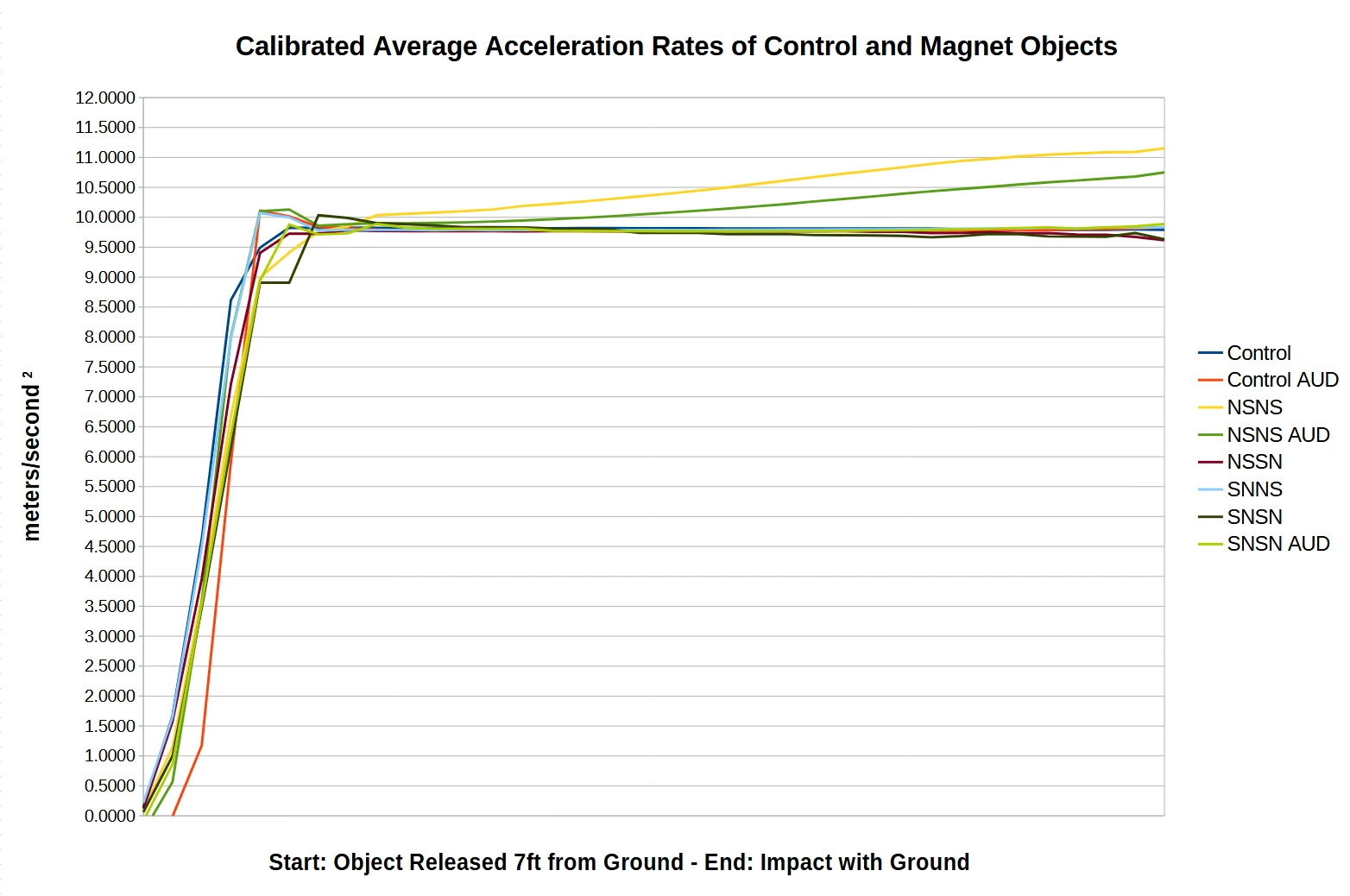Mark 1 – Magnet Free-Fall and Gravitational Mass Experiment
Few magnet free-fall experiments exist in the record and those that do have little data but indicate attractively coupled rare earth magnets fall faster than non-magnetic objects while repulsively coupled magnets fall slower. Experiments using identical rare earth magnets were conducted to add to those results as well as an experiment to determine whether or not gravitational mass and/or inertial mass is being modified. Results show that an attractively coupled magnet in free-fall moving in the direction of north pole to south pole experiences runaway acceleration that no other configuration experiences. Gravitational mass tests with a balance show all magnet objects have almost identical mass indicating inertial mass not gravitational mass is modified by that specific field configuration.
1. Introduction
There are three magnet drop experiments I have come across, one in a published paper and two in Youtube interviews. Senior scientist at Lockheed Martin, Boyd Bushman, reportedly conducted free-fall tests of two repulsively coupled magnets and a control object and observers on the ground stated the repulsively coupled one fell slower [1]. Elio Porcelli and Victo Filho tested two magnets attractively coupled, two repulsively coupled, and a control and reported the attractively coupled one fell the fastest, the repulsively coupled one slowest and the control in the middle. They used an accelerometer to measure the g-forces of the objects in free-fall [2][3]. Finally, the last experimenter on Youtube channel “The Action Lab” [3] tested attractively coupled and repulsively coupled magnets and reported a very slight difference in the recorded fall times of the two which was attributed to experimental error [4].
Adding to the experimental record I tested four different configurations of coupled magnets NSNS, NSSN, SNNS, and SNSN and a control. An accelerometer measured and recorded the g-forces experienced by all objects during free-fall. Singularly the NSNS magnet object experienced runaway acceleration. Gravitational mass experiments found almost no difference in mass and the NSNS magnet object was not the heaviest which would be unexpected from its free-fall results if gravitational mass modification was responsible.
2. Definitions and Methods
The magnet’s used on all magnet objects are RY04X0 neodymium ring magnets from K&J Magnetics, one of their largest axially magnetized magnet with a hole in the center useful for bolting two magnets in a repulsively coupled configuration. The RY04X0 is an N42 magnet 2” in diameter and 1” thick with a 1/4” hole in the center. It has a pulling force of up to 205lbs. Four differently configured magnet objects and a control were used in testing, attractively coupled NSNS and SNSN and repulsively coupled NSSN and SNNS. The first two letters represent the poles of the top magnet while the last two letters represent the poles of the bottom magnet. For example, the NSNS magnet object’s top magnet has the north pole on top and the south pole on the bottom while the bottom magnet also has the north pole on top and the south pole on the bottom facing the ground. AUD stands for Arduino Upside Down indicating the board was flipped inside the shell to determine if the NSNS results were an anomaly due to the Arduno’s orrientation. The control consisted of a thirty seven layers of steel fender washers 2” in diameter with a 1/4” hole in the center.
The control and magnet object free-fall portion of this experiment used the following components in conjunction with each object: 3D printed PLA plastic shell, milled XPS foam pieces acting as a shock absorber, one 1/4”-20 x 4” long aluminum bolt, two 1/4” aluminum washers, one 1/4”-20 aluminum nut, one Arduino Nano 33 BLE Rev2 with built-in accelerometer and gyroscope, one Adafruit Powerboost 500 Basic, and one 3.7V 250mAh Lipo battery. A cellphone with the app Serial Bluetooth Terminal to receive the recorded data from the Arduino Nano over Bluetooth was used with each trial saved as a text file on my phone for later analysis. The height at which the objects were dropped was approximately 7 feet and each object was dropped a total of twenty five times.
The gravitational mass experiment consisted of using a Bonvoisin Lab Scale analytical balance to record the mass of the four differently configured magnet objects. The components used with each magnet object consisted of one 1/4”-20 x 4” long aluminum bolt, two 1/4” aluminum washers, and one 1/4”-20 aluminum nut. Thirty layers of approximately 20mm thick XPS foam were used to separate the magnet objects from the analytical balance to eliminate the magnets from altering the results read by the balance. A magnet pole detector was used at the bottom of the XPS foam block to ensure that it was no longer affected by the magnet objects on top of the foam block. The table below represents the average masses from five mass measurements of each component.
3. Results

Each object’s acceleration rate in the chart above was derived by averaging each of the twenty five trials conducted per object along with applying a one point calibration offset derived from the Control and Control AUD trials subtracting 0.1203 meters/second2 from regular and 0.3815 meters/second2 from Arduino Upside Down acceleration rates respectively.
I have deduced three potential hypotheses for the runaway acceleration seen in the free-fall tests with the NSNS magnet object moving in the direction of north pole to south pole.
- The NSNS magnet’s field increases its gravitational mass while leaving its inertial mass the same causing it to fall faster than other objects.
- The NSNS magnet’s field decreases its inertial mass while leaving its gravitational mass the same causing it to fall faster than other objects.
- The NSNS magnet’s field both increases its gravitational mass and decreases its inertial mass causing it to fall faster than other objects.
The easiest experiment to conduct to determine which hypothesis is correct is to record the masses of the different magnet objects excluding the control object. Each magent object is made of the same fundamental components which are nearly identical in mass as seen in the table below so each magnet object’s mass should be the same if gravitational mass is not being altered which would mean inertial mass is being altered. On the other hand if the NSNS magnet object records a greater mass than the others then gravitational mass is being altered and hypothesis one or three are the possible explanation.
| Masses in Grams | ||||
|---|---|---|---|---|
| NSNS | NSSN | SNNS | SNSN | |
| Aluminum Bolt | 7.642 | 7.648 | 7.658 | 7.658 |
| Aluminum Washers (Qty 2) | 1.282 | 1.318 | 1.296 | 1.296 |
| Aluminum Hex Nut | 1.136 | 1.14 | 1.142 | 1.142 |
| Reported RY04X0 Magnet Mass (Qty 2) | 760 | 760 | 760 | 760 |
| Magnet Object Total Mass | 771.096 | 771.094 | 770.968 | 771.132 |
4. Conclusion
The inertial mass reduction seen with the NSNS magnet object in free-fall has huge implications for air and space travel. A bar magnet type field as seen in a normal magnet can be replicated with a solenoid type electromagnetic coil as it has a north pole on one side and a south pole on the other. Aircraft and spacecraft with a solenoid coil around its axis of travel moving in the direction of north pole to south pole would experience inertial mass reduction allowing the craft to accelerate at higher rates without the craft and its crew experiencing higher g-forces.
It is possible that inertia is a result of virtual particle electron/positron pairs popping in and out of existence as in QFT and that this specific magnetic field around a moving object reduces virtual electron/positron collisions with the object and therefore lowers its inertia. Another possibility is that the field reorrients the virtual particle pairs so when they annihilate the resulting short lived ‘dark’ gamma rays are less likely to collide with the object and impart their momentum. Determining what exactly causes inertia is a huge challenge but determining that a specific type of magnetic field in motion can reduce it is a major step in that process. Another possibility is that an object with a magnetic field, in motion in the direction of north pole to south pole, contracts spacetime at the south pole and expands it at the north pole, a possible warp drive type phenomenon.
The next steps are three-fold. One is to determine if the acceleration of the tested NSNS magnet object ever plateaus. It is possible that at some point the acceleration rate of the object plateaus being limited by the field strength of the coupled magnets. Or it might never plateau and stronger magnets and magnetic fields merely increase the rate of acceleration. Conducting free-fall experiments with the NSNS magnet object from greater heights will give the magnet more time to reach a plateau if there is one. The second is to construct a more aerodynamic shell with fins that move the center of pressure of the free-fall object farther back in order to minimize rotation and tumbling. The third is to use guide wires to eliminate any residual rotation of the NSNS magnet object when being dropped from higher distances to keep the object moving in the direction of north pole to south pole throughout the duration of free-fall.
5. Raw and Collated Data
Download Averaged Collated Data
Download Control Raw Data
Download Control AUD Raw Data
Download NSNS Raw Data
Download NSNS AUD Raw Data
Download NSSN Raw Data
Download SNNS Raw Data
Download SNSN Raw Data
Download SNSN AUD Raw Data
6. References
[1] B. Bushman, Boyd Bushman From Here To Andromeda. https://youtu.be/njIPiuiv9Qo?list=PLJyTIzO6xoFD1M9d5DiDOrnjR4gMR7ChJ&t=585
[2] E. Porcelli et al, New evidences of anomalous forces involving magnetic dipoles in experiments of magnets free fall. https://www.researchgate.net/publication/338686589_New_evidences_of_anomalous_forces_involving_magnetic_dipoles_in_experiments_of_magnets_free_fall
[3] E. Porcelli et al, New Experimental Evidences of Anomalous Forces in Free Fall Locked Magnets.
https://www.researchgate.net/publication/351664636_New_Experimental_Evidences_of_Anomalous_Forces_in_Free_Fall_Locked_Magnets
[4] The Action Lab, Do Magnets Fall Faster Than Non-Magnets? (Boyd Bushman Magnet Drop). https://www.youtube.com/watch?v=uEA1FWLai-c

